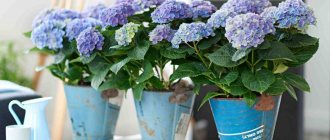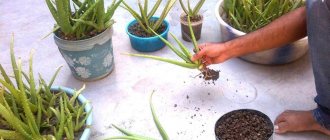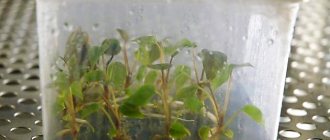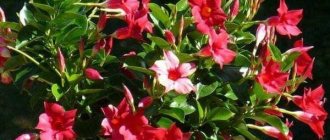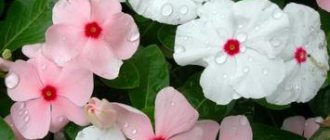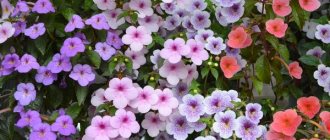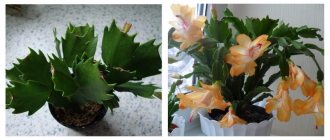A rare flower does not have its own history, full of legends and superstitions. The stone rose, often used in landscape design, is no exception. How to care for it at home?
Stone rose is an exclusively popular name used in Russia and the CIS countries
Botanical description of stone rose (juvenile)
Stone rose is an exclusively popular name used in Russia and the CIS countries. tenacious or hare cabbage, echeveria is also used Translated from Latin as “always alive.”
This unusual succulent consists of many lanceolate, succulent leaves that look like scales. They are located around a straight stem in the form of large or small rosettes (in diameter from 1 to 15 cm in diameter). Star-shaped flowers with a double perianth and many stamens ripen into ovoid fruits from 8 to 20 pieces.
Looking carefully at the plant, you understand why it was named so. Its pattern of leaves resembles a blossoming rose. Often found in the Caucasus and southern North America.
Popular types
Among flower lovers in general and succulents in particular, there are many fans of echeveria. Its unusual rosettes with elastic, fleshy leaves are filled with charm and grace.
Among the great variety, you can choose plants both for home cultivation and for decorating a garden composition .
Graceful (Echeveria elegans)
According to the classification, it is a type of stemless rosette - its leaves are located immediately above the ground.
The elongated leaf plate can reach a length of 5 cm and a width of 2 cm. Important! A bluish coating is observed on the upper part of the leaf.
It is formed by villi that cover the plate itself. Under no circumstances should you try to erase or remove them: mechanical stress will seriously damage the leaves. The rosette of Echeveria gracilis resembles a lotus flower. It blooms profusely, the peduncle produces a long peduncle directed upwards, at its end reddish-pink bells of inflorescences are formed, the end of the bud may turn yellow.
Agave (Echeveria agavoides)
A small bush up to 35 cm in height with a tight rosette resembling a water lily. The rosette is formed by smooth, symmetrically placed pointed leaves.
The color of the leaf blades is light green with a red stripe along the edge. The leaves can reach a length of up to 10 cm, but their width does not exceed 6 cm.
It usually blooms at the very end of autumn - beginning of winter. Flowering is abundant. The corollas are small, most often red or yellow.
Echeveria derenbergii
The creeping variety is distinguished by flat, small rosettes (up to 6 cm in diameter) of a grayish-green tone. The rosette is formed by tightly adjacent spade-shaped leaves with a reddish edge.
The color gains in spring, the peduncles are low, the inflorescences are yellow.
Echeveria setosa
The stem of this beauty is weakly expressed, often it is completely absent. The distinctive feature that became the basis for the name of the succulent is the whitish dense pile on the leaves, which looks like bristles. Setosa forms a rosette of regular spherical shape.
Flowering occurs at the end of spring - beginning of summer. The plant produces a long peduncle, which can reach a height of 30 cm, also covered with villi. The flowers are colored in a gradient red-yellow color.
Humpbacked flower (Echeveria gibbifiora)
This unusual form of succulent has a tree-like branched stem. At the end of each branch there is a dense rosette consisting of 15–20 leaf plates.
The leaves are in the shape of an irregular oval with a curved edge and are colored greenish-gray; on the leaves there are growths of an arbitrary curved shape, due to which the plant was given its name.
The succulent produces a flower stalk at the end of August, and can bloom until mid-winter. The buds are spherical in shape. A very popular variety of hump-flowered echeveria is Magic Red.
Miranda (Echeveria miranda)
Bred by breeders, several varieties of this form have been created. A distinctive feature of the succulent is the group of rosettes located on one stem.
In nature, Echeveria Miranda can reach almost a meter in height. The rosettes look like a lotus flower and have a soft green color.
Black prince
The hybrid variety was obtained through selection. It has a charcoal coloration of small flattened leaf blades.
At the base of the leaves, the rosette has a light green tone, but by the end of the leaves the color becomes almost perfectly black. Black Prince stands out with its bright red flowers - they appear in mid-autumn and last until almost the end of winter.
Lilicina (Echeveria lilacina)
This is a slow growing variety of Echeveria. A dense rosette of grayish-blue leaves with a bluish tint takes a long time to form and can reach 23–25 cm. The peduncles are curved, red in color, the corollas are pink or coral.
The flowering period occurs at the end of winter and lasts until the beginning of summer.
Interesting! If you place a pot with a plant in a window so that the rays of the sun fall directly on the leaves, the lilicina will acquire a white waxy coating. It will disappear if the flower is moved into the shade.
Pulidonis (Echeveria pulidonis)
The rosette is formed by narrow long foliage of soft blue color with pink edging. The diameter of the succulent is usually within 15 cm. Flowering occurs in the summer, the color of the petals is yellow.
Echeveria glauca
The stemless form has an unusual color - pale blue with a bluish tint. Leaf blades up to 10 cm, acquire a pink edging in winter. The succulent blooms in spring with yellow, bell-shaped flowers.
Echeveria affinis
A low-growing variety of succulent - maximum 5 cm in height, the rosette can grow up to 12 cm. The color of the leaves is dark green, almost black. With a lack of ultraviolet radiation, it loses its color intensity and becomes much lighter.
Metal-flowered echeveria
It has a unique metallic sheen and, unlike other echeverias, practically does not bloom.
Echeveria lauii
It is distinguished by large light green leaves covered with a whitish waxy coating. During the flowering period, a characteristic coating appears on the flower petals. This succulent has a clearly visible trunk.
brilliant echeveria
The rosette is round, but the leaves have a geometric appearance. They are elongated, and in some varieties the edge of the leaf is wavy. The color is gray with a green tint. Blooms profusely from mid-winter to mid-spring.
Echeveria shaviana or sho
The beautiful decorative rosette is distinguished by its grayish-violet color and wavy edge on the leaves. It blooms in summer, the succulent profusely produces small pink corollas.
Pearl of Nuremberg (Echeveria Perle von Nurnberg)
Pearl von Nuremberg is distinguished by the intensity of its color (gray-brown) and the size of its leaves (large, with needle-shaped tips on the leaves).
The rosettes are large, the plant trunk is powerful and well defined. There is a popular hybrid form of Rainbow, characterized by a red core.
Desmeta
A classic variety of Echeveria. It has a delicate bluish-green leaf color with pink edging. Blooms with orange bells.
Nodulose
A small dense rosette, compared to other varieties, confidently attracts everyone's attention with its original colors: on the dark leaves there are purple stripes on the upper side, and spots of the same intensity on the lower side.
Amoena
On the plump shoots there are small, round, lush rosettes of bluish-green color.
cushion echeveria
The bush is small, the leaves are oval, elongated, covered with transparent green fibers. It blooms in spring, the color of the bells is red and yellow.
Other varieties of echeveria are also popular: mix, yellow, pink, topsy torvi, globulosa, purpuzorum, tree, picoca.
Signs and superstitions associated with the stone rose
Echevaria has a rather controversial reputation: some believe that the plant does not carry negative emotions, others are afraid to plant hare cabbage at home or in the garden, because they believe in its negative energy. It must be said that the second superstition arose due to the fact that stone roses are often planted in cemeteries. This choice is not surprising, the plant is practically unpretentious, it thrives on stones, it does not need to be watered often, it survives drought calmly and at the same time looks great. But, like any other living creature, the survivor is capable of absorbing bad emotions (but also positive ones).
We also recommend reading:
16 most popular indoor plants Physalis: description of species and varieties, technology for growing from seeds Spruce in landscape design: the best ornamental varieties and characteristics of cultivation Kalanchoe: description of types and characteristics of care at home
And so the plant has had a good reputation since Antiquity. In Ancient Rome, the flower was called a talisman; they believed that it could ward off evil from its owner. This superstition was not forgotten in the later era of the Early Middle Ages: Charlemagne ordered it to be planted on the roofs of houses to “scare off” lightning. So the stone rose became the first “lightning rod”.
There is no need to be afraid of keeping a flower at home because of existing superstitions. In order for him to “cleanse” himself of accumulated negativity, it is enough to simply talk to him often and treat him with love. Then the stone rose will only be a joy; it will become a true decoration for the room.
Echevaria has a rather controversial reputation: some believe that the plant does not carry negative emotions, others are afraid to plant hare cabbage at home or in the garden, because they believe in its negative energy
Plant propagation
Increasing the population of “quarry moths” on the site is possible in 3 ways - seeds, cuttings, children. Growing from seeds is the most painstaking and therefore unpopular type of propagation.
In its natural environment, in the garden, the plant reproduces well on its own without the help of a gardener. The mother rosette forms a baby, which then takes root near it, forming a beautiful “carpet” of young plants.
Propagation by cuttings occurs as follows: a leaf is separated from the mother bush, then the cutting is dried and planted in the soil. Over the course of a year, the seedling develops into a full-fledged plant.
Secrets of caring for a stone rose in the garden
Any garden flowers need to be carefully looked after, only then will they be able to develop properly. And although the survivor is not too whimsical, it is also demanding of certain factors and they should be taken into account.
- The peculiarity of succulents is that they perfectly accumulate water and are able to survive long periods of dry soil without any problems. Therefore, you do not need to water the plant every day, but once or three times a week during particularly hot months. Do not overdo it, otherwise the roots will begin to rot, which almost always leads to death. Keep an eye on the lower leaves, they are the ones who begin to respond to overflow first.
- Carry out the process itself under the plant, the outlet should not be wet.
- Loosening the soil around the crop has the most beneficial effect on it. This helps get rid of weeds, the roots begin to breathe better, and ventilation increases, which prevents moisture accumulation. But keep in mind that the rhizome is almost on the surface, so carry out the process extremely carefully.
- Remove dead plants and weeds in a timely manner.
- What attracts gardeners to the stone rose? It does not need to be fertilized, unlike many other crops. Fertilizing worsens the saturation of the leaves and makes the plant more vulnerable to frost. Only three-year-old flowers need help. Buy a special preparation for succulents and cacti, use only half the volume of the indicated dose.
Light-loving stone roses must be prepared for cold weather. Delicate and delicate flowers will simply die in the first winter. The process itself is not too complicated.
- Prepare shelter. Plastic bottles with a volume of 5 liters are perfect for protection. Cut off the top of them.
- Punch holes with an awl 1 cm from the cut. There shouldn’t be too many of them; five to seven pieces is enough.
- If such a bottle is too large, select another container that is suitable in width. If one container is not enough, then take several pieces.
- Turn the vessel upside down and place it above the flower bed. To prevent it from being blown away by the wind, secure the bottle with metal rivets or pins. That's what the holes are for.
- Carefully cover the one-year-old juveniles with spruce branches, and they will survive their first winter in an open area just fine.
Conditions for normal development and growth of echeveria
With proper care, it is necessary to provide the following conditions for the plant:
- Lighting. At any time of the year there should be enough bright light and direct rays of the sun. It is not advisable to place pots with plants on window sills facing north.
- Glaze. In winter and autumn, you need to water the plant moderately, once a month. In spring and summer, water it more often - when the earthen ball dries out completely. It turns out once every 10 days.
- Air humidity. Spraying the outlet is not required at any time of the year.
- Temperatures. In winter and autumn, the air temperature in a cool room should not fall below +10 degrees. In summer and spring, the temperature should be 22-27 degrees above zero.
Features of the correct growth and development of a stone rose.
Gallery: stone rose flower (56 photos)
Pests and diseases
Juveniles are often affected by various types of rot. When the first signs appear, the plant must be transplanted into another pot or to another place in the garden, cut out the affected part and sprinkle it with coal. If the roots are affected, it is better to simply destroy the diseased plant to avoid the possible spread of the disease.
Among the pests, garden plants are attacked by cockchafers, which can eat long passages in the pulp of the young. Plants must be carefully inspected, damaged ones must be removed and replanted in another place, and the old one must be treated to destroy the beetle larvae.
Juveniles growing on a windowsill have two enemies: aphids and scale insects. To destroy them, you need to use chemicals: “Inta-vir” works well against aphids, “Aktelik” against scale insects.
You can plant different types of juveniles in pots to create a multi-colored carpet. The combination of young and sedum also looks good.
The young flower has not only an interesting decorative appearance, but also useful (medicinal) properties. It serves as an anti-inflammatory agent (medicine), treats stomatitis, stomach ulcers, and diarrhea. Relieves calluses, warts and hemorrhoids. It removes age spots and freckles.
https://youtube.com/watch?v=q8En9H9xZR4
Methods for propagating stone roses
Most people are afraid to purchase several specimens at once, but then they realize the value and beauty of these plants and think about buying a few more succulents. But the tenacious creature reproduces easily, so you don’t have to resort to store services and try to get new stone roses yourself.
There are several methods of propagation: seeds, cuttings or leaves.
Vegetative (cuttings or leaves)
- Choose the healthiest and most beautiful succulent in your flower bed. Separate from it the leaf located closer to the trunk. He shouldn't be too young.
- Or cut off the top of the bush, tearing off the lowest leaves.
- Dry the workpieces for several hours.
- At this time, mix vermiculite and sand in equal proportions. Moisturize it.
- Stick the cutting or leaf into the prepared soil and place it in a well-ventilated and sunny place.
- So the plant should stand for a month. Moisten the soil periodically.
- During these 30 days, in good conditions, an outlet should appear. It will take 2 to 3 months for its final formation. The maternal part will dry out at this time.
- Transplant the new organism into a separate pot with cactus soil.
Seeds
- For this method you will need peat and sand. Place their mixture in a suitable box.
- Stick the seeds shallowly into the ground (4-5 mm). Spray the soil with a spray bottle. Cover everything with film.
- The container is left in a warm (20-25 degrees) and lighted room.
- Moisten the soil as needed.
- After two weeks, the succulents will appear above the ground, and the young ones are transplanted when 2-3 well-developed leaves are formed.
Primary planting and transplantation of echeveria
After purchasing echeveria, some gardeners recommend immediately replanting the plant from shipping soil, since it is not intended for plant growth.
Experienced succulent lovers say that nothing will happen to the plant after a month in the transport soil; this time will give the flower an opportunity to acclimatize, survive stress, and get used to new living conditions. Place the pot in a slightly shaded place and dry until aerial roots begin to appear. This is especially true for imported flowers (Dutch flowers). Sometimes stone roses do not survive the move and disappear for no apparent reason. Plants grown in local nurseries tolerate changes more easily.
Typically, such material is of higher quality and costs more. However, it should also dry out in the window. What soil mixture should I plant echeveria in? In its natural environment, it is a rocky desert, where water does not stay at the roots. The same should happen in the pot. The substrate must be mixed with small pebbles, broken bricks, gravel (fraction 3-5 mm).
Several options can be recommended:
- garden soil - 3 parts,
- small pebbles - 1 part,
- peat – 1 part,
- charcoal - a little;
or:
- substrate for cacti or succulents - 4 parts,
- pebbles – 1 part;
You can use clean pea gravel plus a little cialite (if slow plant development is desired). It’s easy to check if the soil mixture has been mixed correctly - a lump of wet substrate, held in your hand, crumbles after being squeezed.
Choosing a pot for a stone rose is a simple matter. You know the approximate diameter of the plant, take a pot 1-1.5 cm larger, flat (to match the root system) with many drainage holes. Small planting material can be planted in small cups for growing, and then transplanted to a permanent place.
A large pot or bowl is used for group plantings of one or different types of echeveria. To prevent water from stagnating in large containers, they need to be watered with extreme care.
We fill the bottom of the pot with drainage and some substrate, place the plant and fill it with substrate up to the root collar. If planting in clean gravel, then cover the bottom a third with pebbles, place the seedling and fill the remaining volume with them. This method is very simple and economically justified, since the stones last forever and perfectly aerate the roots. There is one warning - for large plants we use gravel of a larger fraction.
We replant small roses once a year, and as they grow, we select a larger pot. Mature plants - once every three years (as needed).
Options for using stone roses in landscape design
Succulents can pleasantly diversify the look of a garden, adding zest and some warmth to it. The uniqueness of the plant lies in the fact that it is very beautiful, but at the same time it has a green or burgundy tint that is pleasant to the eye. It’s hard to overdo them, so they can be used in absolutely any volume.
- As already mentioned, echveria does not combine well with other flowers due to the fact that it does not receive enough light. Therefore, you need to carefully select other crops. It’s better to do without them, the stone rose is already quite original.
- The combination of pebbles (decorative stones) and hare cabbage is the most impressive. Tender and succulent succulents look very beautiful together with neutral and harsh gray-brown tones. Therefore, if you doubt your abilities as a decorator, choose young ones. It requires very little effort and material, and the result will be wonderful.
- Stone roses look great in individual pots. There is absolutely no need to buy new ones! Broken or outdated containers will do, as long as they are well cleaned. For beauty, you can paint “patches” in especially worn places. Place it on the ground side up and let your imagination run wild! Gardeners even use old shoes, and succulents look great in them.
Stone rose goes well in any composition. They can be used with anything (as long as they follow the prescribed rules).
Stone rose goes well in any composition
Landing
The plant is very unpretentious. It grows even on rocky and poor soils.
You can propagate it:
- seeds;
- vegetatively.
Seeds
Propagating young ones by seeds is quite difficult and difficult. Only fresh seeds are suitable for planting, otherwise the result may tend to zero.
It is best to use the seeds soon after collection or purchase. To maintain freshness, it is recommended to store the collected seeds in tightly closed containers. This way they will be protected from moisture.
The seeds are very small. Because of this, they are easily washed off and blown off the soil. Therefore, you should strictly follow the technology of planting young seeds.
More information about growing young from seeds can be found here.
In open ground
- First you need to prepare the soil at the sowing site.
- The soil must be well loosened and weeds and their roots removed.
- For sowing, make small depressions at a distance of about 4 cm.
- After sowing, the seeds are not sprinkled on top, but watered with water from a spray bottle and lightly pressed down.
About planting and caring for juveniles in the open ground, as well as suitable varieties, is discussed here.
In room conditions
- Soil is poured into a shallow wide pot. If the soil is mixed independently, then it should contain limestone, charcoal, peat, sand. Mixtures for cacti are used from ready-made soils. Cover the soil with a layer of 5 - 10 centimeters.
- The soil is compacted and moistened with ordinary water or root. Lightly compact and sow the seeds. Plant at a shallow depth and sprinkle with light substrate.
- The container is covered with glass or transparent film. Then the pot is placed in a bright place with a constant temperature of about 20 degrees.
- The soil is kept constantly moist and ventilated daily.
- After 2 weeks, the film (glass) is removed. The seedlings are picked and transplanted into other pots.
Watch a video about how juveniles are grown by seeds:
Children
A simple and affordable method is the main natural method of plant propagation. Therefore, to quickly increase the number of sockets, it is recommended.
On the street
- Choose a sunny place for planting. At this place the soil is prepared. The soil is cleared of weed roots, loosened and watered. If the soil is heavy and “oily,” then remove 5–10 centimeters of soil. A peat-sand mixture is poured into the resulting groove - one part peat is added to three parts sand.
- Rosettes with tendrils and a lump of earth on the roots are separated from the mother plants. The sockets should already be rooted.
- The rosettes are planted at a distance of 10 - 15 centimeters by simply pressing them into the ground along with a lump of earth on the roots. There is no need to worry about the roots - they will not be harmed. Dig in the free end of the tendril and carefully water it, preventing water from getting on the plant itself. Be sure to plant a rosette with a tendril. If this is not done, the time for rooting and development will increase significantly.
- Further care involves removing weeds from the soil between the plants. When the young plants have grown sufficiently, they begin to care for them as for adult plants.
At home
- Prepare the soil for planting children. The best option would be soft and loose soil with a high sand content. You can also use specialized soil for cacti.
- Next, you should add charcoal and expanded clay to the ground. The bottom of the planting container must be drained. The height of the drainage layer is 5 - 6 centimeters. Drainage is necessary to prevent moisture stagnation in the pot.
- Immediately before planting, you can treat the roots with a product to enhance their growth. In this way, accelerated rooting is achieved.
- Plants are planted in shallow holes at a distance of 5 - 10 centimeters. The roots must be completely immersed in the hole. Sprinkle soil on top and press down lightly.
- After planting, water a little with a syringe just under the very root of the future rosettes.
- In the future, all care consists of moderate regular watering. It is recommended to alternate plain water and a 0.5% fungicide solution.
Watch a video about how young people reproduce with children:
You can read more about growing young at home here.
Features of growing stone roses at home
Juveniles are also excellent for home growing. It should be remembered that in indoor conditions the flower takes root very well, but after that it can no longer be transplanted to an open area, as it simply will not take root.
In principle, the rules of care do not really change:
- Choose exclusively southern sides so that the survivor can receive enough sunlight every day. Even on western and eastern windows there will be a shortage, and on northern windows the succulent will completely wither.
- If you want his plant, but you don’t have enough sun at home, then build a source of additional lighting.
- Juveniles need to be watered very rarely. Just two or three times in the winter months and once a week in the summer is enough.
- Don't think there isn't enough moisture. It is more dangerous to overwater a flower than to underwater it, since it tolerates drought very well and rarely dies from lack of water.
- Use a mixture of sand, peat or leaf soil as soil. Loosen it carefully from time to time.
Since stone roses are practically not susceptible to pests and diseases, they will appeal to lovers of indoor plants. Weeds and cockchafers do not threaten them, the main thing is not to overwater them so that the root system does not rot.
Care and cultivation in open ground
Site preparation
First you need to decide on the place where the plant will be planted and the best place will be a well-lit area where no shadow falls. After all, a darkened area will eventually destroy the plant.
Since the plant is not picky, it can be grown in any soil, but sandy and well-drained soil is best. You can also use garden vases and marble flower beds.
- Before planting the plant in open ground, you need to thoroughly clear the soil of weeds. It is necessary to make small depressions in the soil and begin planting plants at a distance of 5 cm to 20 cm. Immediately after planting, the young must be watered. With proper care, the plant will grow on the site within a year.
- Planting in a flower bed follows the same principle. You can make the soil yourself; to do this, add some brick chips, gravel and expanded clay to the soil and sand (proportion 1:1). Also, after planting from above, it is also recommended to sprinkle the soil with expanded clay.
- The distance between seedlings should be at least ten centimeters. In this case, next year the young will grow, and baby cuttings will appear around each plant.
Plant care
- Caring for it is easy, for the reason that frequent watering and fertilizer are not required. If the weather conditions are not very dry, then additional watering may not be necessary. It must be remembered that water should not get into the sockets. We must not forget that emerging weeds must be removed and the soil loosened. It is important to remember that the roots of the plant are shallow, so you need to carefully loosen the soil so as not to damage the root system.
- It is best to cover the plant for the winter so that it does not die from excess moisture or severe frost. To do this, you can use various available means, for example, plastic bottles.
- On the site, the young plant goes well with other plants. But you need to remember that lush plants growing nearby can cause harm due to the shadow they can create.
Useful video
When planting young on the site, you need to remember about the dangers that lie in wait for the plants. These are, first of all, birds that peck at rosettes. May beetle larvae can also cause harm as they gnaw through the root. Rotting of plants in rainy weather or excessive watering is also one of the dangers.
